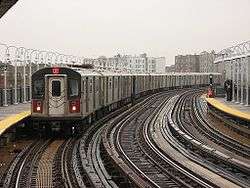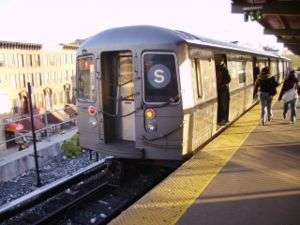R11/R34 (New York City Subway car)
| R11 | |
|---|---|
|
R11/R34 car 8013 at Rockaway Park - Beach 116th Street Station during a fan trip on August 3, 2014. | |
|
Interior of an R11/R34 car. | |
| Manufacturer | Budd Company |
| Built at | Philadelphia, Pennsylvania |
| Constructed | 1949 |
| Refurbishment | 1964-1965 |
| Scrapped | 1980 |
| Number built | 10 |
| Number preserved | 1 |
| Number scrapped | 9 |
| Fleet numbers | 8010-8019 |
| Capacity | 56 (seated) |
| Operator(s) | New York City Subway |
| Specifications | |
| Car body construction | Stainless steel |
| Car length |
over coupler faces: 60 ft 3 in (18.36 m) |
| Width | 10 ft (3.05 m) |
| Height | 12 ft 2.125 in (3.71 m) |
| Floor height | 2 ft 10.125 in (0.87 m) |
| Platform height | 3 ft 10 in (1.17 m) |
| Doors | 8 |
| Maximum speed | 55 mph (89 km/h) |
| Weight |
Before overhaul: 81,476 lb (36,957 kg) After overhaul: 82,500 lb (37,421 kg) |
| Traction system | Westinghouse type ABS switch group (model UP631B) with Westinghouse XM179 master controller, using 4 General Electric 1240B motors (100 hp or 75 kW each). 4 motors per car (2 per truck - all axles motorized). |
| Power output | 100 hp (75 kW) per traction motor |
| Acceleration | 2.5 mph/s (4.0 km/(h·s)) |
| Auxiliaries |
Before overhaul: Edison B4H (32 Volt) battery with 24 cells. Battery charged primarily by Westinghouse XF23A motor alternator After overhaul: Edison B4H (32 Volt) battery with 24 cells. Battery charged primarily by YX304E motor generator |
| Electric system(s) | 600 V DC Third rail |
| Current collection method | Top running Contact shoe |
| Braking system(s) |
Before overhaul: WABCO schedule SMEE with ME-42 brake stand and drum brakes. Air provided by WABCO 3-Y-C compressor After overhaul: WABCO schedule SMEE with ME-42 brake stand and disk brake rigging. Air provided by WABCO 3-Y-C compressor |
| Coupling system | WABCO H2C |
| Track gauge | 4 ft 8 1⁄2 in (1,435 mm) |
The R11 was a prototype class of experimental New York City Subway cars built by the Edward G. Budd Manufacturing Company in 1949.
Because each one cost more than $100,000, the ten R11 cars are frequently referred to as the Million Dollar Train. From 1964 to 1965, the ten R11 cars were overhauled in the Transit Authority's own Coney Island Complex under contract R34. Therefore, it is also acceptable to refer to the cars as R34s, provided one is referring to them in their post-overhaul state.
The R11 was the first stainless steel R-type car (The Budd BMT Zephyr holds the title of being the first stainless steel subway car in the city). Fifteen years after building the R11s, the Budd Company built the first bulk order of stainless steel cars in New York City Subway history, the R32.
Background and description
Design and rebuild
On June 19, 1947, the city announced the details of the $1,158,000 R11 subway car order. The equipment in the subway car was installed by Westinghouse Electric.[1]
The full size of the R11 contract was to have been for 400 new subway cars, intended to provide service on the planned Second Avenue Subway. The subway, which was then slated to open in the 1950s, had been repeatedly delayed throughout its history, and the 10 cars ordered were to serve as a newest technology prototype test train available at the time. However, the remainder of the cars were never built due to the halt of construction on Second Avenue shortly thereafter.
The ornamental design of the car body featured standee windows separated by a heavy brace from the lower windows. This was due to the influence of noted industrial designer Otto Kuhler (US patent Des.153,367), and featured as part of a bid by the American Car and Foundry Company in 1947. The cars also implemented new technology in several areas. "Precipitron" lamps were included, designed to combat airborne bacteria. Forced air ventilation was introduced as ceiling vents circulated fresh air in from outside each car, while removing stale air. Electric door motors were used for the first time, replacing the standard compressed air engines which had served on much of the older equipment. However, these cars were also built with outside door operating apparatus or controls along with an exterior mounted Public Address microphone system. Lastly, drum brakes were installed instead of conventional tread brakes.
The R11 cars originally used storm doors that were similar to those used in later SMEE cars, but by the early 1950s, those storm doors were modified to feature circular windows similar to those on the R15, R16, and R17 cars.[1]
The R11 cars were rebuilt in 1965 under contract R34. During the rebuild, the drum brakes were replaced with disk brakes, new fans were installed, and the middle stanchions were removed to improve passenger flow. The rebuild also included modifications that allowed the cars to operate in consists with other SMEE (contracts R10 through R42) cars.
Retirement and after-service life
Since there were only ten of them, maintenance for the R11s proved time consuming and difficult by the 1970s, as special skills and components were needed to keep the cars in working order. As a result, the R11s were retired from service in 1977 following a yard accident that wrecked car 8016, and 9 of the 10 cars were scrapped by 1980.
The one exception is car 8013, which survives today at the New York Transit Museum. The car was restored to operating condition from 2013-2014 and made its first in-service run in 37 years on a nostalgia trip on August 3, 2014, mated to R16 6387. Rainy weather the night before the run short-circuited the overhead electrical wiring in the car, causing the car to run with its interior lights off. The wiring, along with a leak in the roof were extensively repaired at the 207th Street Overhaul Shop.
Further reading
- Sansone, Gene. New York Subways: An illustrated History of New York City's Transit Cars. Johns Hopkins University Press, Baltimore, 2004 ISBN 0-8018-7922-1 pp. 193 – 194
References
- 1 2 "NEW STAINLESS STEEL TRAIN FOR THE SUBWAY". New York Times. June 20, 1947. Retrieved February 21, 2016.
External links
![]() Media related to R11/R34 (New York City Subway car) at Wikimedia Commons
Media related to R11/R34 (New York City Subway car) at Wikimedia Commons



